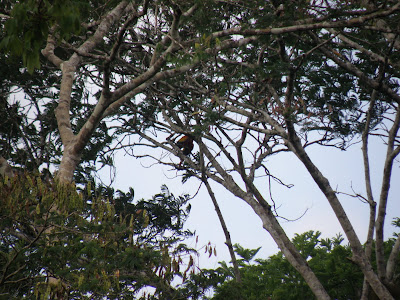Female Scarlet stands guard at the entrance to her nest. Notice the nest is on a dead tree. This is just one of the many nesting trees which died after the reservoir was flooded. The dam brought higher energy rates at the expense of an endangered and declining species. Not only did nesting trees get affected, but also critical foraging habitat.
Approaching the confluence. This used to be a
large floodplain with dozens of large Quamwoods suitable for nesting and as
food source. Now, only a few dry trunks pierce above the waterline. Yet, the
beauty in the background still reminds us of the magic left in this forest...
Why I work in the natural
world? For its sheer beauty and staggering resilience! The Chiquibul has
survived the country's largest and most devastating Hydro dam, poaching every
year for the past two decades and beyond, illegal hunting and logging in multi
million figures, illegal farming and settlements... its been thru it all. Yet,
the beauty within, springs right back, sometimes in the simplicity of a gentle
rainfall over the canopy... sometimes in a towering and more formidable manner.
This year our colleagues
from WCS-Guatemala once again sent us help. Here one of their expert climbers
goes up to retrieve the chicks from the nest. Below our wildlife vets wait
anxiously to begin health checks.
Dr. LoraKim Joyner shows me that the stet goes on the chest, not the head, to listen for
heartbeats. LOL. I was listening to neural activity.
Hope
in such a tiny body. And to think that this lil scarlet could bring new genes
to this isolated population, hope for the species, all in such a tiny lil body!
Listening to a tiny Scarlet Macaw chick's heart
beat. It instills so much hope into me, replenishes my pride and polishes my
determination to help save these iconic birds of the Maya Forest.
Check out posts by our Partners:
http://www.lafeberconservationwildlife.com/the-flight-continues-scarlet-macaw-conservation-in-belize/
https://www.facebook.com/media/set/?set=a.503983529648988.1073741834.389169111130431&type=1
Check out posts by our Partners:
http://www.lafeberconservationwildlife.com/the-flight-continues-scarlet-macaw-conservation-in-belize/
https://www.facebook.com/media/set/?set=a.503983529648988.1073741834.389169111130431&type=1































































